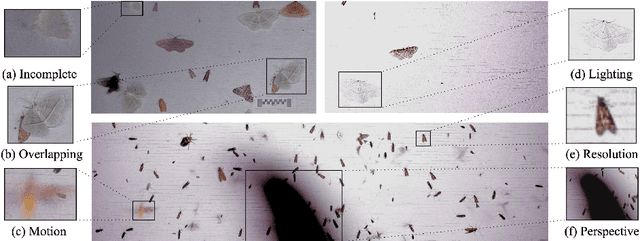Léonard Pasi
A machine learning pipeline for automated insect monitoring
Jun 18, 2024Abstract:Climate change and other anthropogenic factors have led to a catastrophic decline in insects, endangering both biodiversity and the ecosystem services on which human society depends. Data on insect abundance, however, remains woefully inadequate. Camera traps, conventionally used for monitoring terrestrial vertebrates, are now being modified for insects, especially moths. We describe a complete, open-source machine learning-based software pipeline for automated monitoring of moths via camera traps, including object detection, moth/non-moth classification, fine-grained identification of moth species, and tracking individuals. We believe that our tools, which are already in use across three continents, represent the future of massively scalable data collection in entomology.
Insect Identification in the Wild: The AMI Dataset
Jun 18, 2024



Abstract:Insects represent half of all global biodiversity, yet many of the world's insects are disappearing, with severe implications for ecosystems and agriculture. Despite this crisis, data on insect diversity and abundance remain woefully inadequate, due to the scarcity of human experts and the lack of scalable tools for monitoring. Ecologists have started to adopt camera traps to record and study insects, and have proposed computer vision algorithms as an answer for scalable data processing. However, insect monitoring in the wild poses unique challenges that have not yet been addressed within computer vision, including the combination of long-tailed data, extremely similar classes, and significant distribution shifts. We provide the first large-scale machine learning benchmarks for fine-grained insect recognition, designed to match real-world tasks faced by ecologists. Our contributions include a curated dataset of images from citizen science platforms and museums, and an expert-annotated dataset drawn from automated camera traps across multiple continents, designed to test out-of-distribution generalization under field conditions. We train and evaluate a variety of baseline algorithms and introduce a combination of data augmentation techniques that enhance generalization across geographies and hardware setups. Code and datasets are made publicly available.
 Add to Chrome
Add to Chrome Add to Firefox
Add to Firefox Add to Edge
Add to Edge